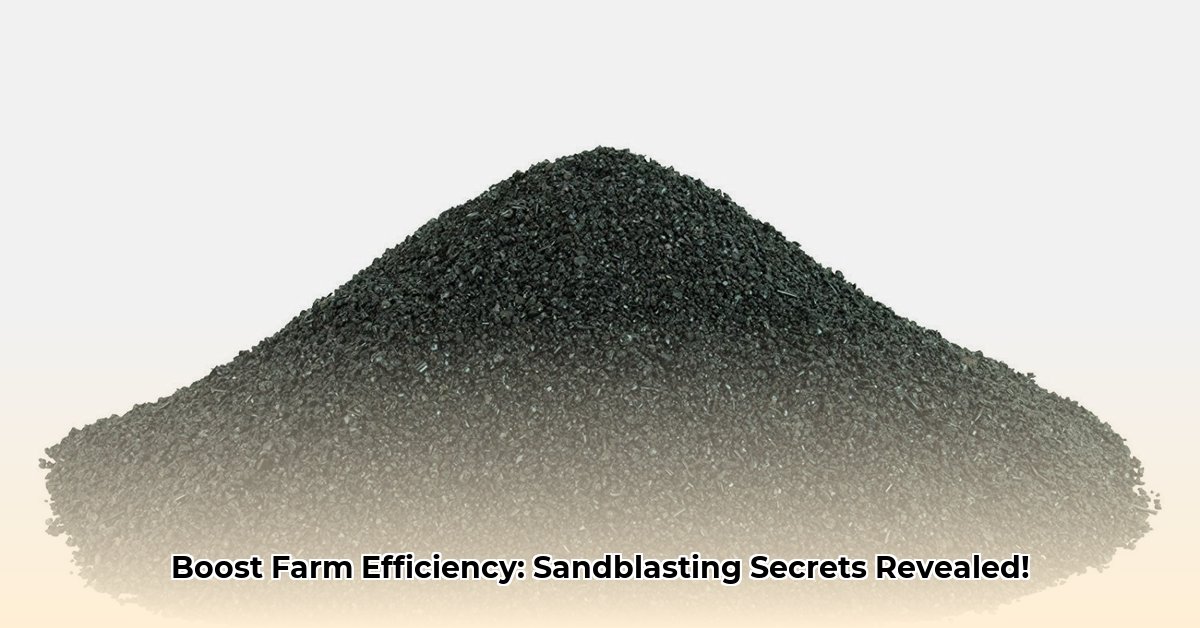
Sandblasting Tractor Supply: Giving Your Farm Equipment a New Lease on Life
Revitalizing your aging farm equipment doesn't have to be a Herculean task. Imagine effortlessly removing stubborn rust and peeling paint, preparing your tractors and machinery for a fresh, protective coat. That's the power of sandblasting—a game-changer for extending the life of your valuable assets. This isn't just about aesthetics; it's about preserving the functionality and longevity of your farm's core machinery. Ignoring rust and corrosion can lead to costly repairs. Sandblasting helps you avoid these potentially disastrous and expensive scenarios. How can you improve the efficiency of your sandblasting operations? Need a tractor? Check out tractor rental prices here.
Understanding the Magic of Sandblasting
Sandblasting uses compressed air to forcefully propel abrasive particles (often sand) onto a surface. This process aggressively removes rust, old paint, and other grime, leaving behind clean, bare metal ready for repainting or further repairs. It’s like a supercharged power wash, but far more effective and precise. Proper preparation through sandblasting is key to a long-lasting finish.
Why is this crucial? Rust weakens metal, leading to premature equipment failure. Sandblasting removes this threat, significantly extending equipment lifespan. But isn't there a better, more efficient way to handle this process?
Choosing the Right Sandblasting Setup for Your Needs
Selecting the appropriate sandblasting equipment depends on the project’s scale. Smaller projects might suffice with a portable sandblaster. For larger machinery, a more robust, industrial-strength system is necessary. Your local farm supply store or equipment rental service can advise on the optimal choice for your needs and budget. A crucial element is always safety. A high-quality respirator is essential – protecting your respiratory system is non-negotiable. What are the steps to ensure safety during this process?
Sandblasting Your Tractor: A Step-by-Step Guide to Success
Safety First! Before starting, ensure you have a respirator, safety glasses or a face shield, and heavy-duty gloves. Work in a well-ventilated area, preferably outdoors.
Prep Work: Thoroughly clean the tractor's surroundings. Remove debris that could interfere with the process or become airborne. Use painter's tape to mask areas you don't want blasted.
Setting Up Your Equipment: Position your sandblaster for easy access. Securely connect it to a powerful air compressor that meets the sandblaster’s requirements.
Test Run: Before blasting the entire tractor, perform a test blast on a small, inconspicuous area. Adjust pressure as needed. This prevents damage.
The Blasting Process: Maintain a 6-12 inch distance from the surface. Use consistent, even movement. Avoid lingering in one spot to prevent gouging. Work methodically, section by section.
Post-Blast Cleaning: After sandblasting, thoroughly clean the tractor to remove all sand and debris. Use a stiff brush and compressed air.
Beyond Sandblasting: A Holistic Approach to Equipment Maintenance
Regular maintenance is crucial for keeping your machinery in top shape. This proactive approach minimizes downtime and maximizes operational efficiency. Regular cleaning, lubrication, and prompt attention to minor issues significantly reduce the likelihood of costly repairs. What are the benefits of combining sandblasting with a robust maintenance plan?
Integrating Sustainable Farming Practices: Data-Driven Decisions and Environmental Stewardship
Precision agriculture, using technology to gather data for targeted interventions, reduces waste and improves yields. This includes using sensors, GPS, and software to optimize irrigation, fertilization, and pest control. What are some ways technology can improve sustainable farming practices?
Precision Agriculture: Data-Driven Decisions
- Soil Sensors: Monitor soil moisture and nutrient levels for optimized irrigation and fertilization, reducing waste.
- GPS-Guided Machinery: Ensures precise application of inputs, minimizing overlap and ensuring even coverage.
- Drone Technology: Used for crop monitoring, early disease detection, and yield estimation.
- Data Analysis Software: Interprets data from various sources, informing decision-making.
Example: A farm using precision agriculture reduced water consumption by 20% and fertilizer use by 15% while increasing yields by 10%.
Sustainable Irrigation Techniques
Efficient water management is crucial. Consider:
- Drip Irrigation: Delivers water directly to plant roots, minimizing evaporation and runoff.
- Rainwater Harvesting: Collects rainwater for irrigation.
- Smart Irrigation Systems: Optimize water delivery based on real-time conditions.
Crop Rotation and Cover Cropping
These practices improve soil health, reduce pest and disease pressure, and enhance biodiversity.
Conclusion: Sustainable farming practices, combined with technology, offer a path toward increased efficiency, reduced costs, and enhanced environmental stewardship. Integrating precision agriculture, efficient irrigation, and careful soil management builds resilient businesses and contributes to a healthier planet. Sandblasting, as a vital maintenance component, plays a significant role in this equation.